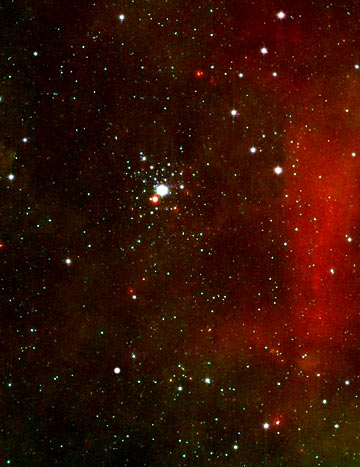If the disk of gas around a young star wants to form Jupiter-size planets, it’s got to do it fast, according to research announced on Monday at the American Astronomical Society meeting in Long Beach, California.

The bright young star cluster NGC 2362 in Canis Major, imaged in the infrared by the Spitzer Space Telescope. (The brightest star is Tau Canis Majoris.) The cluster is only 5 million years old, but already the solar-mass stars in it have lost their protoplanetary disks of gas and dust. This suggests that gas-giant planets must form rapidly and efficiently.
Alan MacRobert
Theoretical models of protoplanetary disks show that dust bits, rocks, and ice will clump together to form "planetesimals," the asteroid-like seeds of future planets. When one becomes large enough to have noticeable gravity it starts to pulls stuff in faster and begins runaway growth. If it accumulates several Earth masses of solid material, its gravity becomes great enough to pull in and hold onto large quantities of gas from the disk — dozens to hundreds of Earth masses of it. Voilà, a Jupiter is born!
Most computer models have indicated that this "core-accretion" process for giant planets takes 5 to 10 million years. But new results, from Thayne Currie (Harvard-Smithsonian Center for Astrophysics) and his colleagues, push this timescale down to only 4 or 5 million years. Using NASA’s Spitzer Space Telescope, they studied protoplanetary disks in the star cluster NGC 2362 in Canis Major, well known to amateur telescope users. Previous research had narrowed down the age of this cluster to about 5 million years.
In the youngest clusters, like the one in the Great Orion Nebula, newborn stars are surrounded by thick protoplanetary disks with plenty of material remaining to form giant planets. Even if the disks can't be seen directly, they show up as an excess of infrared emission from the star.
But Spitzer’s infrared observations show that protoplanetary disks in NGC 2362 had virtually disappeared around all the cluster's stars except those with the lowest masses. So this implies that by the time a Sun-like star reaches 5 million years, its raw material for giant-planet formation is gone.
And yet, giant planets are common. “Planets like Jupiter have to form very, very, very fast, faster that we thought before, especially around high-mass stars,” says Currie. “Whatever process is responsible for forming Jupiters has to be incredibly efficient.” Rocky planets like Earth, by comparison, are thought to take 20 or 30 million years to grow to their final sizes.
But Carol Grady (Eureka Scientific and NASA/Goddard Space Flight Center), who studies disks around stars of different ages, cautions that star ages within a cluster are often uncertain by several million years. She adds, “Isolated stars can hold onto disk material much longer, while denser clusters can lose their disks on shorter timescales” due to irradiation from nearby hot stars. (But that shouldn't apply to NGC 2362.) "The significance of Currie's work," she continues, "is that it further constrains the epoch of planet formation, bringing it into agreement with recent dating of Saturn's formation via cooling-time arguments for Iapetus."
Also, it’s known that several exoplanets contain extremely large masses of rock and/or ice, not just gas. Putting this all together, it seems likely that giant planets may form by more than one process, and over a broad range of timescales.
 1
1
Comments
Rod
January 7, 2009 at 6:43 pm
This is an intriguing report here. I too enjoy viewing NGC 2362 in winter skies, I viewed this cluster on 12/29/08 in my backyard. What strikes me, solar mass stars are apparently reported very young, perhaps 5 million years old on conventional H-R diagram interpretation and lack protoplanetary disks. Other nearby stars like Tau Ceti or Epsilon Eridani exhibit large dust disks, the disks appear to contain much mass and for a star with a stellar evolution age like Tau Ceti some 8-10 billion years old (or older depending upon various H-R diagram models), this dust disk should long ago have dissipated or eroded using the conventional age for Tau Ceti.
Perhaps these 'young' stars in NGC 2362 formed without the disks, now that would be something.
You must be logged in to post a comment.
You must be logged in to post a comment.